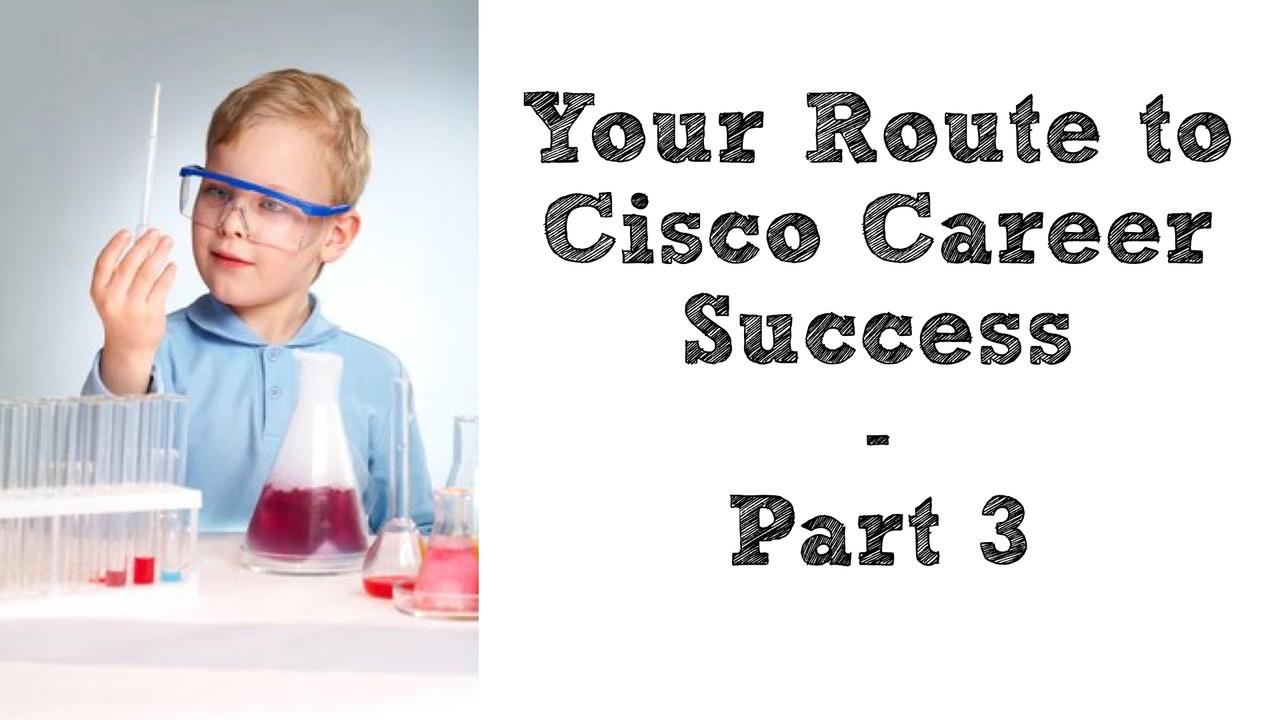Your Route to Cisco Career Success – Part 3: The Curiosity Key
Nov 18, 2015
Walt Disney is one of my personal heroes, and the following quote from him beautifully sets the stage for this blog post’s topic, curiosity:
We keep moving forward, opening new doors, and doing new things, because we’re curious, and curiosity keeps leading us down new paths.
– Walt Disney
Curiosity about how something works spurs on mastery of that topic. It motivates us to want to learn more. This blog post examines some of the benefits of having a healthy curiosity, steps to further develop your curiosity, and another tale from the trenches that illustrates how curiosity led to the development of one of my most popular Cisco training videos.
The Benefits of Curiosity

Albert Einstein said, “The important thing is not to stop questioning. Curiosity has its own reason for existing.” Are you curious how curiosity can help us in our Cisco careers? Let’s consider just a few benefits of curiosity.
- Motivation: Becoming more knowledgeable in your field and advancing in your career takes effort. It’s all too easy for us to not push ourselves on to the next level, but curiosity can help give us the sorely needed motivation.
- Learning: Personal confession time… When I was a student at the University of Kentucky, getting my Bachelor of Science in Electrical Engineering degree, I wasn’t as curious as I should have been. Engineering classes tend to be very mathematical. A significant percentage of class time was spent by the professors working out mathematical proofs, showing that particular equations (e.g. Maxwell’s equations, describing electromagnetic field theory) were indeed correct. My perspective was, “I trust you! Just give me the formula, without proving it, and let me do something useful with it.” Looking back, I realize that I could have learned the material at a much deeper level had I been curious about those seemingly boring proofs. Fortunately, my attitude changed when I dove into learning about computer networking. I remember reading about TCP/IP many years ago, and I was so fascinated about the inner-workings of the protocol suite that I got a notebook and started documenting what I was learning (e.g. the different fields in the TCP header). My curiosity helped me learn better and made me want to learn.
- Troubleshooting: One of the most common tasks of network engineers is that of troubleshooting network issues. Troubleshooting can be emotionally charged, with end users frustrated about the issue they’re experiencing and with network engineers sometimes frantically trying to resolve the issue. However, if the troubleshooter approaches the issue with curiosity, they can often resolve the issue much quicker than haphazardly trying one thing, and then another, and then another until the issue is finally resolved. Specifically, curiosity leads us to question things, even things that might appear obvious. This questioning often uncovers the underlying issue that needs fixing.
How to Cultivate Your Curiosity
At this point, you’re hopefully sold on the concept of curiosity being a very positive characteristic to have as a Cisco professional. This then leads to the question of how we cultivate a stronger curiosity within ourselves. Here are a few tips:
- Study: Earlier I stated that having curiosity helps us learn. Now allow me to suggest that the corollary is also true. By studying and learning more about a topic, you tend to develop a deeper curiosity about that topic. For example, consider two network engineers. They have the same amount of experience, but the first engineer studies Cisco technologies on their own time, while the second engineer just learns on the job.
Let’s further assume that they are each assigned to troubleshooting a Spanning Tree Protocol (STP) issue in their network. Who do you think will ask the more effective troubleshooting questions?
The engineer who had been studying on their own time might look at the issue and be curious about which switch in the topology is acting as the root bridge and about the bridge priority of that switch.
The engineer who had not done as much independent study, might ask less effective questions. While they might be curious as to why the network wasn’t working correctly, their level of curiosity is constrained by their lack of understanding about the operation of STP.
The conclusion that we can draw is that the more we know about a technology, the more curious we become and the more effective questions we can ask.
- Teach: When you teach a course, or a single concept, to someone else, the act of preparing to teach creates curiosity about your subject matter. If there are any lingering questions you have about a topic, you’re more curious about those questions, since your students might have those questions too. For example, you might think, “What if a student asks this? How would I answer it?”
Being a traditional teacher, standing up in front of a class, is not in everyone’s DNA. However, there are other ways to teach what you know. You can teach somebody one-on-one. You could write a technical white paper, or record a video tutorial. Whatever way best suits you, I encourage you to teach.
- Try something new: Stepping outside our wheelhouse and into the realm of uncertainty stimulates our curiosity. After all, there are so many unknowns to be curious about. For example, if you’re primarily focused on Cisco Unified Communications implementations, you might volunteer to help with a very different technology, such as a security project (e.g. installing a Cisco Adaptive Security Appliance (ASA)).
- Create a test bed: The term test bed is often used to refer to an isolated collection of equipment on which you can perform experiments without impacting a production network. Having such a set of experimental equipment at your disposal allows you to play what I call “what if games.” If you’re curious as to what would happen in a production network if you performed a certain configuration, you could safely try it out in your test bed.
For example, you might curiously ask yourself, “What convergence time would I get if I reconfigured the Hot Standby Router Protocol (HSRP) Hello timer on my routers.” If you had a test bed environment, you could duplicate a portion of your production network and quickly determine the convergence time. This could then lead to the next question, and the next, and so on.
A Tale from the Trenches
While studying for my second attempt at the CCIE Voice lab, one of the technologies on the lab blueprint that I (and many other lab candidates) found most challenging was Quality of Service (QoS) configuration on Cisco Catalyst 3750 Series switches.
After reading through the Cisco docs, whitepapers from CCIE training companies, and doing practice labs, I still didn’t completely get it. For example, the way Shared Round Robin and Shaped Round Robin worked was very confusing and unlike any other Cisco technology I’d ever seen.
I’d been creating YouTube training videos for some time, and I decided that what the industry needed was a comprehensive training video on Cisco Catalyst 3560 and 3750 QoS. Not only would creating such a video fill a need in the training space, it would force me to learn the technology such that I could explain it to others.
So, I got incredibly curious about all aspects of QoS on these switches. I would dissect the Cisco documentation and rewrite what I was learning, in my own words. The result was a 1 hour and 45 minute video entitled Cisco Catalyst 3560 and 3750 QoS Simplified… Seriously! This video has since become the most popular videos on my YouTube channel and has helped many CCIE R/S and CCIE Voice/Collaboration candidates get a better handle on this challenging topic.
This blog posting is the third in the “Your Route to Cisco Career Success” Series. You can read the first two installments here:
Your Route to Cisco Career Success – Part 1: Goals: Your Destination Address
Your Route to Cisco Career Success – Part 2: When Life Gets in the Way

Kevin Wallace, CCIEx2 (R/S and Collaboration) #7945, CCSI 20061
If you enjoyed this article, you might also want to subscribe to my podcast:
iTunes: http://kwtrain.com/podcast


